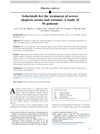TLDR Combining triamcinolone acetonide and immunotherapy can help regrow hair in some alopecia totalis patients.
The study assessed the potential for hair regrowth in 10 patients with alopecia totalis (AT) who did not respond to topical immunotherapies. Patients received monthly injections of triamcinolone acetonide (TA), followed by immunotherapy using squaric acid dibutylester (SADBE) or diphenylcyclopropenone (DPCP) if vellus hair developed. The complete response rate to TA was 10%, while the partially good response rate was 60%. Good responders showed the anagen stage of hair follicle after TA injections, and the complete responder exhibited further hair regrowth with subsequent immunotherapy. The study suggested that even long-term AT patients could potentially recover their hair cycle with this combined treatment approach.
44 citations
,
April 2017 in “International Journal of Dermatology” No treatment is completely effective for alopecia totalis and alopecia universalis.
 238 citations
,
November 2016 in “Journal of The American Academy of Dermatology”
238 citations
,
November 2016 in “Journal of The American Academy of Dermatology” Tofacitinib is effective and safe for severe hair loss, but full regrowth is less likely after 10 years of hair loss.
15 citations
,
April 2016 in “The Journal of Dermatology” Multiple courses of pulse corticosteroid therapy improve hair growth in alopecia areata patients with minimal side effects.
11 citations
,
May 2013 in “Journal of the American Academy of Dermatology” Hydroxychloroquine helped two people regrow hair lost from alopecia totalis.
 218 citations
,
April 2012 in “British Journal of Dermatology”
218 citations
,
April 2012 in “British Journal of Dermatology” Guidelines suggest various treatments for alopecia areata, but leaving it untreated is also an option as 80% cases may recover on their own.
1 citations
,
March 2017 in “PubMed” Topical minoxidil did not significantly regrow hair in alopecia areata patients after 3 months.
 November 2016 in “대한피부과학회지”
November 2016 in “대한피부과학회지” The document's conclusion cannot be summarized as it is not provided in a language I can understand.
January 2014 in “DOAJ (DOAJ: Directory of Open Access Journals)” Minoxidil can effectively treat patchy hair loss by stimulating hair growth.



